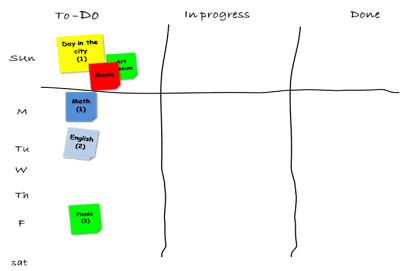Here we are again, presenting
another fun and creative way to arrange our tasks to help us get things done.
Today, I want to introduce to you
- The Mind Map.
I’ve even published an article
about mind mapping the software testing exploratory technique myself.
Mind mapping is one of the
most powerful visualization tools for ideas, flows, goals - whatever we
want to achieve. It works wonders with kids, as they visualize their way
through the things they want to do.
Why use it at home?
Because it is another way that
helps us get things done. Because it works for so many people. Because It is so
simple and effective, that I just had to talk about it.
As usual, I want to keep
things simple. I prefer to use mind mapping as an initial tool to initiate our
wish list, to get our to-do list in order.
But first, what exactly is mind
mapping?
"A mind
map is a diagram used to
represent words, ideas, tasks, or
other items linked to and arranged around a central key word or idea… Mind maps
have many applications in personal, family, educational, and business situations, including notetaking,
brainstorming (wherein ideas are inserted into the map radically around the
center node, without the implicit prioritization that comes from hierarchy or
sequential arrangements, and wherein grouping and organizing is reserved for
later stages), summarizing, as a mnemonic technique, or to sort out a complicated idea.
Mind maps are also promoted as a way to collaborate in color pen creativity
sessions.
Mind maps can be used for:
● problem solving
● outline/framework design
● structure/relationship representations
● anonymous collaboration
● marriage of words and visuals
● individual expression of creativity
● condensing material into a concise and memorable format
● team building or synergy creating activity
● enhancing work morale”
Kids are doing it all over the world any way. So how do
we do it?
Lets say we have this three week vacation coming up, and we
want to plan what we want to do. As a regular reader of my blog you already
know, that the best thing to do is build a mind map as a family, together.
Visualize it, talk it over, and have fun with it!
1. So the first step of mind mapping will be to visualize
a central word, topic, idea, subject, or concept.
Say - Holidays family activities.
2. Now, we add three or
four ideas that are linked to the main idea.
Think , for example , what would
we like to do in that period of time ?:
‘Have fun’
‘Do homework’
‘Paint the house’
3. Now continue to add even more ideas under those
ideas. Use bright colors! Arrows! Colored lines! Anything that makes the
mind map easy and fun to follow.
4. Now, can we actually do everything we set down in
the mind map? Well, luckily, you used sticky notes. Move them around, see
what’s really important, and add them to a board. Call this your ‘To do’
column.
5. Now add two more columns - ‘In progress’ and ‘Done’.
See?
Mind maps are used all over, for
all sorts of things. Education, life skills, chores, and so on. For us, it's
just another fun way to help us get things done.
Citations:
● Mind map pattern from : Tony Buzan © 2004 "Mind Maps for
Kids : Rev up for Revision"






















